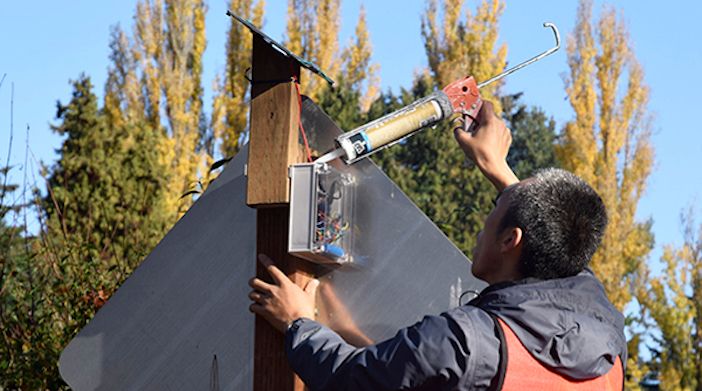With the number of pedestrian road deaths in the USA steadily increasing, researchers at the University of Washington’s Department of Civil and Environmental Engineering have been developing a new system that they hope will make travel safer for pedestrians and bicyclists.
According to the National Highway Traffic Safety Administration (NHTSA), the most recent data reveals that in the USA in 2016 a pedestrian was killed every 1 hour and 30 minutes and a pedestrian injured every eight minutes. Four years ago, there was a pedestrian fatality every two hours.
To help keep pedestrians safe, a team of researchers at UW’s STAR (Smart Transportation Applications and Research) Lab is building a new type of communications system that connects various roadway users and sends safety warnings to both pedestrians and drivers, alerting them of potential conflicts in their oncoming path.
Called the Smart Road Sticker (SRS), the technology consists of a small, solar-powered device that acts as a hub to facilitate communication between roadway users. Installed on light poles or other infrastructure near the roadway, the basic function of the SRS is to detect wireless signals from mobile devices that have the STAR Detection app installed, as well as communicate with vehicles through onboard wireless communication units (OBUs).
The app enables people to receive safety notifications, warning them of hazards such as a driver who has failed to stop at an intersection. The alerts can be relayed to drivers either via the app on their smartphone or through the in-vehicle navigation system.
To identify unsafe conditions and determine appropriate safety responses, a crash prediction algorithm was developed that calculates if there will be a conflict between non-motorized roadway users and vehicles using information gathered from OBUs, such as location, speed and direction of travel.
The algorithm identifies the location of pedestrians and other non-motorized roadway users through the app. Sensors embedded in the SRS device also gather information from nearby infrastructure, such as when traffic lights turn red or green.
To factor in response time for both drivers and non-motorized users, the algorithm calculates a safety threshold for critical situations, keeping a safe distance between vehicles and pedestrians. Once the algorithm estimates the collision risk, there is a reasonable window of time to warn both pedestrians and drivers to take appropriate action.
To test the system, the researchers installed three SRS devices on the Burke-Gilman Trail in Lake Forest Park. The location was selected because the trail, which is heavily used by both pedestrians and bicyclists, is intersected by roads and driveways. The researchers also previously tested the system using traffic flow simulation software, to evaluate the system under various traffic and landscape conditions. The results indicate that the number of conflicts decreases when the number of connected devices increases.
“It is important to provide a new technology to give notice to drivers when pedestrians are coming, so drivers can slow down,” said UW researcher Yifan Zhuang (below). “The next step is evaluating the technology based on the performance and improving it to make it smaller and more accurate.”





